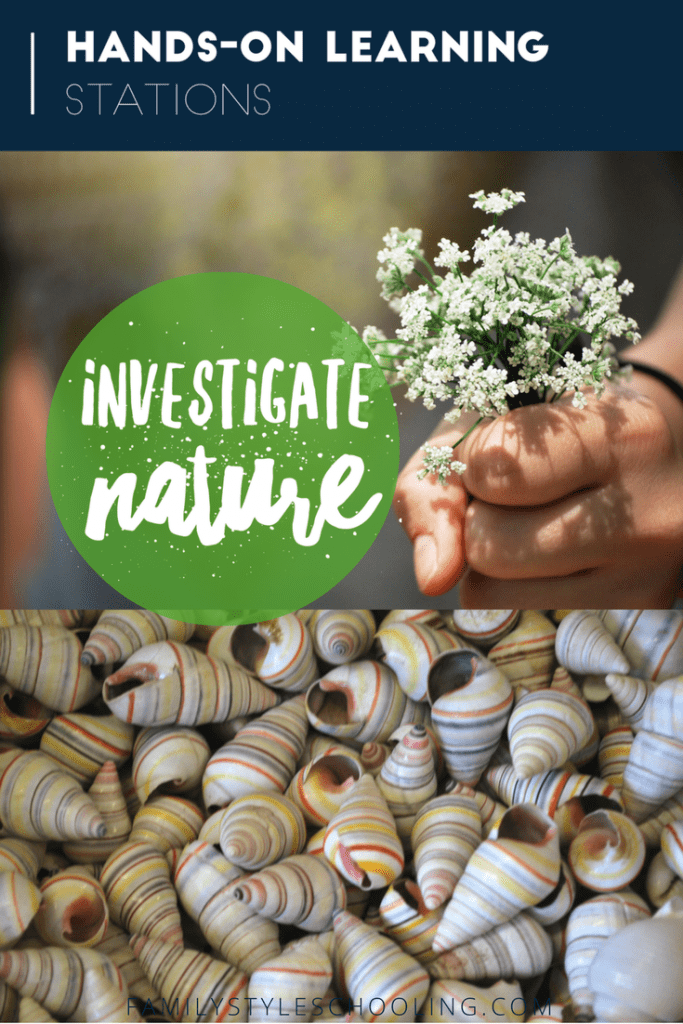Investigate Nature: Hands-On Learning Stations
Nature is a source of fascination for kids of all ages. There are fascinating patterns, shapes, and colors hiding in the most mundane of items. With a field guide, a magnifying glass, and a microscope, children will find endless sources of fascination. You don't have to have access to acreage or a creek in your back yard to enjoy investigating nature.
There are so many great resources for children to experience nature from your living room. I'm continuing my 31+ Days of Hands-On Learning Stations with hands-on learning stations that center around the STEM subjects (science, technology, engineering, and mathematics). Here are some great ideas for investigating nature from your living room.

Investigating Nature for Young Ones
If you have preschoolers or kindergartners in your home, they can be entertained for short periods of time with objects from nature that will inspire their curiosity. Here is a simple activity to do with young ones:
Nature Walk Activities
When you go on a nature walk, collect leaves, acorns, and rocks. After you get home, you will have an abundance of resources for hands on learning. Here are some options:
- Sort out the loot. You can sort by type, size, or color.
- Leaf rubbings - put a leaf under a piece of paper and rub over the paper with a crayon.
- Leaf crafts:
Investigating Nature for Older Kids
As kids get older, the opportunities for exploring nature become limitless. We love identifying rocks, birds, and plants with good nature handbooks. Additionally, I've invested in some magnifying glasses (from Dollar Tree) that will help kids take a deeper look at the specimen in front of them.
The other tool that my elementary kids love is our handheld microscope. It connects to the laptop or TV to bring mundane objects to life. It is extraordinary what things look like up close!
Here are some great avenues of research:
Rocks
We love collecting and investigating rocks. If you don't live in a place with a great variety of rocks, then invest in a rock kit, or this rock game that provide ample resources.

Feathers
While it is illegal to pick up feathers in many places, you can find feathers to observe in nature kits like this. See if you can identify what kind of bird the feather came from, and then look at it under the microscope. It is stunning!
Owl Pellets
You might think I'm crazy, but owl pellets are really quite fascinating. Since owls can't digest the bones of the critters they eat, they cough them up like cats do a fur ball. This mix of bone and hair can be investigated to see what kind of creature the owl last ate.
This is a great station to set up OUTSIDE as it is messy and might smell a little. But oh how much fun this is! Once kids find a bone and recognize it as a bat wing, or a mouse skull, they'll be hooked. It takes observation skills to the max in a memorable way.
Endless Options for Observation
Really, there are endless options for creating a hands-on nature station. Use the resources in your front or back yard and let the kids glean goodness.

How do you experience nature with your kids?
Check out more hands-on learning stations inspiration in my 31+ Days of Hands-On Learning series! Here are some more hands-on learning stations that feature science concepts.
Science Stations
- Construction Fun
- Snap Circuits
- Balance Practice
- Engineering Feats
- Cultivating Curiosity with Documentaries
- Computer Science
- Fire Prevention and Safety
Check out the rest of the series for stations featuring other subjects:
Betsy Strauss is an unexpected homeschooler, mother of three, who is in a relationship with a sweet man for life. She loves reading books, drinking coffee, and learning anything with her kids.



